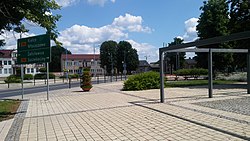Secemin
Secemin | |
|---|---|
Village | |
 Market Square in Secemin | |
| Coordinates: 50°46′4″N 19°50′18″E / 50.76778°N 19.83833°E | |
| Country | |
| Voivodeship | |
| County | Włoszczowa |
| Gmina | Secemin |
| Population | |
| • Total | 1,600 |
Secemin [sɛˈt͡sɛmin] is a village in Włoszczowa County, Świętokrzyskie Voivodeship, in south-central Poland. It is the seat of the gmina (administrative district) called Gmina Secemin. It lies historic Lesser Poland, approximately 14 kilometres (9 mi) south-west of Włoszczowa and 57 km (35 mi) west of the regional capital Kielce.[1] The village used to be a town from 1401 to 1869. Its name comes from the local swamps, called sece.
History
Secemin has a long and rich history, which dates back to a defensive gord, established in the 13th century among swamps and forests, in the proximity to the medieval merchant routes. Earliest documented mention of Secemin comes from the year 1291, when Duke of Kraków and Sandomierz, Bolesław V the Chaste met here with monks from Henrykow. In the 14th century, Secemin was a settlement, with a watermill and a forge, as well as a Roman Catholic parish church.
In 1401, Secemin received
Secemin remained in the hands of the Szafraniec family, which resided in a fortified manor house. Krzysztof Szafraniec, the son of Piotr Szafraniec, was a
Secemin prospered in the period known as the Polish Golden Age. The decline of the town began during the catastrophic Swedish invasion of Poland (1650s), when it lost most of the population, which was replaced by Jewish settlers. Secemin remained in the hands of the Szafraniec family until the mid-17th century, when, as a dowry, it was transferred to Jan Samuel Czarnocki (Lis coat of arms), the husband of Zofia Szafraniec. The Czarnockis owned the town until 1788, building here a manor house, which was demolished in the 1970s.
Until the
Among points of interest there is a Gothic church (1402), which from 1554 to 1617 was a Calvinist prayer house. There also are remains of a 16th-century moat, which protected the Szafraniec family manor house.



